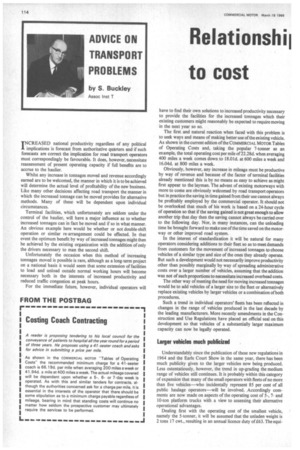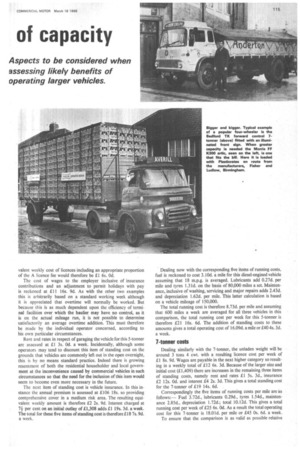Relationshil to cost
Page 116

Page 117

Page 118

If you've noticed an error in this article please click here to report it so we can fix it.
have to find their own solutions to increased productivity necessary to provide the facilities for the increased tonnages which their existing customers might reasonably be expected to require moving in the next year so so.
The first and natural reaction when faced with this problem is to seek ways and means of making better use of the existing vehicle. As shown in the current edition of the COMMERCIAL MOTOR Tables of Operating Costs and, taking the popular 7-tonner as an example, the total operating cost per mile of 22.28d. when averaging 400 miles a week comes down to 18.01d. at 600 miles a week and 16.04d. at 800 miles a week.
Obviously, however, any increase in mileage must be productive by way of revenue and because of the factor of terminal facilities already mentioned this is by no means as easy to achieve as might first appear to the layman. The advent of existing motorways with more to come are obviously welcomed by road transport operators but in practice the saving in time gained from their use cannot always be profitably employed by the commercial operator. It should not be overlooked that much of his work is based on a 24-hour cycle of operation so that if the saving gained is not great enough to allow another trip that day then the saving cannot always be carried over to the following day. Nor, in many instances, can the unloading time be brought forward to make use of the time saved on the motorway or other improved road system.
In the interest of standardization it will be natural for many operators considering additions to their fleet so as to meet demands from customers for the movement of increased tonnages to choose vehicles of a similar type and size of the ones they already operate. But such a development would not necessarily improve productivity other than possibly marginally by way of spreading administrative costs over a larger number of vehicles, assuming that the addition was not of such proportions to necessitate increased overhead costs.
The other way of meeting the need for moving increased tonnages would be to add vehicles of a larger size to the fleet or alternatively replace existing vehicles by larger vehicles or a combination of both procedures.
Such a trend in individual operators' fleets has been reflected in changes in the range of vehicles produced in the last decade by the leading manufacturers. More recently amendments in the Construction and Use Regulations have placed an official seal on this development so that vehicles of a substantially larger maximum capacity can now be legally operated.
Larger vehicles much publicized
Understandably since the publication of these new regulations in 1964 and the Earls Court Show in the same year, there has been much publicity given to the larger vehicles now being produced. Less ostentatiously, however, the trend in up-grading the medium range of vehicles still continues. It is probably within this category of expansion that many of the small operators with fleets of no more than five vehicles—who incidentally represent 85 per cent of all public haulage operators—will be involved. Accordingly comments are now made on aspects of the operating cost of 5-, 7and 10-ton platform trucks with a view to assessing their alternative operational advantages.
Dealing first with the operating cost of the smallest vehicle, namely the 5-tonner, it will be assumed that the unladen weight is 2 tons 17 cwt., resulting in an annual licence duty of £63. The equi valent weekly cost of licences including an appropriate proportion of the A licence fee would therefore be £1 6s. Od.
The cost of wages to the employer inclusive of insurance contributions and an adjustment to permit holidays with pay is reckoned at £11 16s. 9d. As with the other two examples this is arbitrarily based on a standard working week although it is appreciated that overtime will normally be worked. But because this is as much dependent upon the efficiency of terminal facilities over which the haulier may have no control, as it is on the actual mileage run, it is not possible to determine satisfactorily an average overtime addition. This must therefore be made by the individual operator concerned, according to his own particular circumstances.
Rent and rates in respect of garaging the vehicle for this 5-tonner are assessed at £1 3s. Od. a week. Incidentally, although some operators may tend to discount this item of standing cost on the grounds that vehicles are commonly left out in the open overnight, this is by no means standard practice. Indeed there is growing resentment of both the residential householder and local government at the inconvenience caused by commercial vehicles in such circumstances so that the need for the inclusion of this item would seem to become even more necessary in the future.
The next item of standing cost is vehicle insurance. In this instance the annual premium is assessed at £106 18s. so providing comprehensive cover in a medium risk area. The resulting equivalent weekly amount is therefore £2 2s. 9d. Interest charged at 7+ per cent on an initial outlay of £1,308 adds £1 19s. 3d. a week. The total for these five items of standing cost is therefore £18 7s. 9d. a week. Dealing now with the corresponding five items of running costs, fuel is reckoned to cost 3.10d. a mile for this diesel-engined vehicle assuming that 18 m.p.g. is averaged. Lubricants add 0.27d. per mile and tyres 1.31d. on the basis of 80,000 miles a set. Maintenance, inclusive of washing, servicing and major repairs adds 2.43d. and depreciation 1.62d. per mile. This latter calculation is based on a vehicle mileage of 150,000.
The total running cost is therefore 8.73d. per mile and assuming that 600 miles a week are averaged for all three vehicles in this comparison, the total running cost per week for this 5-tonner is therefore £21 16s. 6d. The addition of standing costs to these amounts gives a total operating cost of 16.09d. a mile or £40 4s. 3d. a week.
7-tonner costs
Dealing similarly with the 7-tonner, the unladen weight will be around 3 tons 4 cwt. with a resulting licence cost per week of
£1 8s. 9d. Wages are payable in the next higher category so resulting in a weekly total of £12 6s. 3d. Because of the larger size and initial cost (£1,409) there are increases in the remaining three items of standing costs, namely rent and rates £1 5s. 3d., insurance
£2 12s. Od. and interest £4 2s. 3d. This gives a total standing cost for the 7-tonner of £19 14s. fid.
Correspondingly the five items of running costs per mile are its follows:— Fuel 3.72d., lubricants 0.29d., tyres 1.54d., maintenance 2.85d., depreciation 1.72d.; total 10.12d. This gives a total running cost per week of £25 6s. Od. As a result the total operating cost for this 7-tormer is 18.01d. per mile or £45 Os. 6d. a week.
To ensure that the comparison is as valid as possible relative to the type of vehicle included, an articulated outfit will be selected for the 10-tonner with the tractive unit having much in common with the 7-ton four-wheeler. Operating costs are calculated on a similar basis as with the rigid vehicle except that an appropriate adjustment is made in respect of calculating depreciation to allow for the differing estimated life of tractive unit and trailer.
Accordingly the five items of standing costs per week for this 10-ton artic. are licence £2 8s. 6d., wages £12 6s. 3d., rent and rates £1 8s. 6d., insurance £3 9s. 10d., interest£35s. ld.; total£22 18s. 2d. Running costs per mile are:— fuel 5.07d., lubricants 0.30d., tyres 2.42d., maintenance 3.13d., depreciation 2.27d.; total 13.19d. Therefore the total operating cost for this 10-ton artic. when averaging 600 miles a week is 22.35d. a mile or £55 18s. Od. a week.
Comparing the results obtained for all three vehicles, it will be seen that whilst—in round figures—the total operating cost per week is £40 and £45 respectively for the 5and 7-tonners the increased carrying capacity of the larger vehicle, namely 40 per cent is obtained at an additional cost of 124 per cent. Obviously to realize the potential benefit the additional profitable traffic must be forthcoming. But it should not be overlooked that the difference between 40 per cent and 124 per cent in capacity and cost respectively does allow for some margin of underloading on the larger vehicles for example in the initial stages whilst extra custom is being built up.
Likewise comparison between the 7and 10-tonners shows that a capacity increase of 43 per cent is achieved at around a 24 per cent increase in cost.
Finally the 100 per cent increase in capacity from 5 to 10 tons is achieved at an increase of £16 in the total operating cost per week, namely from £40 to £56 or 40 per cent.




































































































































































